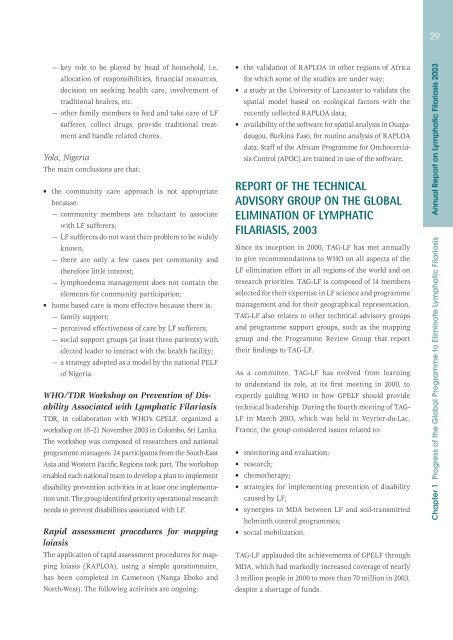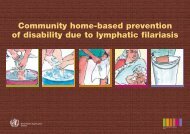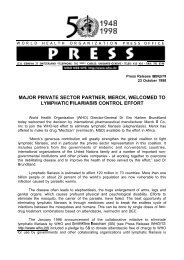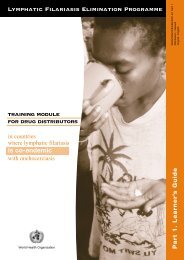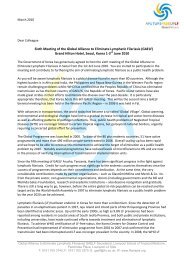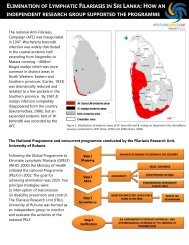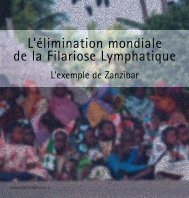Global Programme to Eliminate Lymphatic Filariasis ... - libdoc.who.int
Global Programme to Eliminate Lymphatic Filariasis ... - libdoc.who.int
Global Programme to Eliminate Lymphatic Filariasis ... - libdoc.who.int
Create successful ePaper yourself
Turn your PDF publications into a flip-book with our unique Google optimized e-Paper software.
29— key role <strong>to</strong> be played by head of household, i.e.allocation of responsibilities, financial resources,decision on seeking health care, involvement oftraditional healers, etc.— other family members <strong>to</strong> feed and take care of LFsufferer, collect drugs, provide traditional treatmentand handle related chores.Yola, NigeriaThe main conclusions are that:• the community care approach is not appropriatebecause:— community members are reluctant <strong>to</strong> associatewith LF sufferers;— LF sufferers do not want their problem <strong>to</strong> be widelyknown;— there are only a few cases per community andtherefore little <strong>int</strong>erest;— lymphoedema management does not contain theelements for community participation;• home based care is more effective because there is:— family support;— perceived effectiveness of care by LF sufferers;— social support groups (at least three patients) withelected leader <strong>to</strong> <strong>int</strong>eract with the health facility;— a strategy adopted as a model by the national PELFof Nigeria.WHO/TDR Workshop on Prevention of DisabilityAssociated with <strong>Lymphatic</strong> <strong>Filariasis</strong>TDR, in collaboration with WHO’s GPELF, organized aworkshop on 18–21 November 2003 in Colombo, Sri Lanka.The workshop was composed of researchers and nationalprogramme managers: 24 participants from the South-EastAsia and Western Pacific Regions <strong>to</strong>ok part. The workshopenabled each national team <strong>to</strong> develop a plan <strong>to</strong> implementdisability prevention activities in at least one implementationunit. The group identified priority operational researchneeds <strong>to</strong> prevent disabilities associated with LF.Rapid assessment procedures for mappingloiasisThe application of rapid assessment procedures for mappingloiasis (RAPLOA), using a simple questionnaire,has been completed in Cameroon (Nanga Eboko andNorth-West). The following activities are ongoing:• the validation of RAPLOA in other regions of Africafor which some of the studies are under way;• a study at the University of Lancaster <strong>to</strong> validate thespatial model based on ecological fac<strong>to</strong>rs with therecently collected RAPLOA data;• availability of the software for spatial analysis in Ouagadougou,Burkina Faso, for routine analysis of RAPLOAdata. Staff of the African <strong>Programme</strong> for OnchocerciasisControl (APOC) are trained in use of the software.REPORT OF THE TECHNICALADVISORY GROUP ON THE GLOBALELIMINATION OF LYMPHATICFILARIASIS, 2003Since its inception in 2000, TAG-LF has met annually<strong>to</strong> give recommendations <strong>to</strong> WHO on all aspects of theLF elimination effort in all regions of the world and onresearch priorities. TAG-LF is composed of 14 membersselected for their expertise in LF science and programmemanagement and for their geographical representation.TAG-LF also relates <strong>to</strong> other technical advisory groupsand programme support groups, such as the mappinggroup and the <strong>Programme</strong> Review Group that reporttheir findings <strong>to</strong> TAG-LF.As a committee, TAG-LF has evolved from learning<strong>to</strong> understand its role, at its first meeting in 2000, <strong>to</strong>expertly guiding WHO in how GPELF should providetechnical leadership. During the fourth meeting of TAG-LF in March 2003, which was held in Veyrier-du-Lac,France, the group considered issues related <strong>to</strong>:• moni<strong>to</strong>ring and evaluation;• research;• chemotherapy;• strategies for implementing prevention of disabilitycaused by LF;• synergies in MDA between LF and soil-transmittedhelm<strong>int</strong>h control programmes;• social mobilization.TAG-LF applauded the achievements of GPELF throughMDA, which had markedly increased coverage of nearly3 million people in 2000 <strong>to</strong> more than 70 million in 2003,despite a shortage of funds.Annual Report on <strong>Lymphatic</strong> <strong>Filariasis</strong> 2003Chapter 1 Progress of the <strong>Global</strong> <strong>Programme</strong> <strong>to</strong> <strong>Eliminate</strong> <strong>Lymphatic</strong> <strong>Filariasis</strong>


